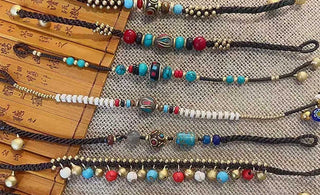
Tibetan traditional accessories carry a profound symbolism deeply rooted in spirituality, culture, and history. These artifacts, ranging from intricately carved bone jewelry to ornate amulets and talismans, serve as tangible representations of Tibet's rich heritage and spiritual beliefs. Each piece is not merely an adornment but a vessel carrying layers of symbolism, connecting wearers to ancient traditions and profound spiritual meanings.
1.Historical Context and Cultural Heritage
Tibetan traditional accessories are steeped in a history that spans centuries, embodying the cultural legacy of the region. Craftsmanship techniques passed down through generations contribute to the exquisite beauty and intricate designs seen in these artifacts. The artistry involved in creating these accessories is not just about aesthetics; it's a tribute to the heritage and craftsmanship unique to Tibet.
2.Materials and Symbolic Meanings
The choice of materials in crafting these accessories holds significant symbolism. Bone, for instance, represents impermanence and the cycle of life and death in Tibetan culture. The meticulous carving and shaping of bones into beads, pendants, and inlays serve as a reminder of the transient nature of existence, echoing the Buddhist principle of impermanence.
The "Wealth Old Tibetan Antique Thangka Purely Hand-painted Menbris Sama Style" exemplifies the profound connection between cultural identity and traditional Tibetan accessories. Beyond being a visually stunning artifact, it encapsulates the essence of Tibetan heritage, serving as a poignant symbol of cultural identity and expression.
Thangkas, such as the "Menbris Sama Style," are revered within Tibetan culture as sacred paintings that depict various aspects of Buddhist teachings, deities, and spiritual concepts. They are not mere artistic creations but representations of spiritual narratives and cultural symbolism. This particular Thangka style, distinguished by its hand-painted craftsmanship and adherence to traditional methods, holds immense significance in preserving Tibetan heritage.
The intricate details and vibrant colors of the Menbris Sama Style Thangka convey more than artistic prowess; they serve as a visual chronicle of Tibetan history and spirituality. Each stroke of paint on the fabric carries the stories, beliefs, and traditions of the Tibetan people, reflecting their deep-rooted connection to Buddhism and their unique cultural identity.
Through wearing or displaying such a Thangka, individuals express not just an appreciation for aesthetics but a profound affiliation with Tibetan heritage. It becomes a statement of cultural belonging, a proud proclamation of one's roots, and a tangible link to the stories and traditions passed down through generations.
Moreover, the act of preserving and showcasing these traditional artifacts is a testament to the resilience of Tibetan culture in the face of modernity. As societies evolve and embrace change, holding onto these relics becomes an act of defiance against cultural erosion. The "Wealth Old Tibetan Antique Thangka Purely Hand-painted Menbris Sama Style" stands as a guardian of traditions, preserving the essence of Tibetan cultural practices in an ever-changing world.
For many wearers or collectors, possessing such a Thangka is akin to holding a piece of living history: a connection to a heritage that transcends geographical boundaries. It's a representation of pride in one's cultural identity and a means of sharing the richness of Tibetan heritage with the world.
3.Iconography and Spiritual Representation
Many traditional Tibetan accessories feature intricate religious iconography. Symbols like the endless knot, representing the interconnectedness of all things, or the lotus flower, symbolizing purity and enlightenment, are commonly incorporated into these artifacts. Each symbol carries profound spiritual meanings rooted in Tibetan Buddhist beliefs, offering wearers a connection to spiritual concepts and teachings.
4.Amulets, Talismans, and Protection
Beyond their aesthetic allure, Tibetan accessories often serve as protective talismans or amulets. The symbols and mantras inscribed on these artifacts are believed to offer spiritual protection and ward off negative energies. They are worn with reverence and faith, serving as a shield against adversity and a conduit for spiritual blessings.
5.Cultural Identity and Expression
Wearing traditional Tibetan accessories is a way for individuals to express their cultural identity and affiliation with Tibetan heritage. These artifacts serve as markers of belonging, carrying with them the stories and traditions of the Tibetan people. They are also a means of preserving and celebrating cultural practices in an ever-changing world.
6.Rituals and Ceremonies
In Tibetan society, traditional accessories play a pivotal role in rituals and ceremonies. From weddings to religious ceremonies, these artifacts hold ceremonial significance, symbolizing blessings, unity, and spirituality. They become integral parts of rites that mark important life events, infusing these occasions with cultural depth and spiritual resonance.
7.Contemporary Relevance and Global Influence
Despite their deep roots in tradition, Tibetan accessories continue to captivate global audiences. Their unique craftsmanship, intricate designs, and spiritual symbolism appeal to individuals seeking not just adornments but also a connection to spiritual and cultural heritage. In a rapidly changing world, these artifacts serve as reminders of the enduring power of tradition and spirituality.
In conclusion, Tibetan traditional accessories transcend mere fashion statements; they are repositories of history, culture, and spirituality. Their symbolism, craftsmanship, and spiritual significance make them more than just adornments: they are conduits for connecting wearers to a profound spiritual and cultural legacy that continues to resonate across time and borders. As these artifacts traverse global boundaries, their sacred significance and symbolism continue to captivate and inspire, fostering a deeper understanding and appreciation of Tibetan heritage.

Wealth Old Tibetan Antique Thangka Purely Hand-painted Menbris Sama Style
























